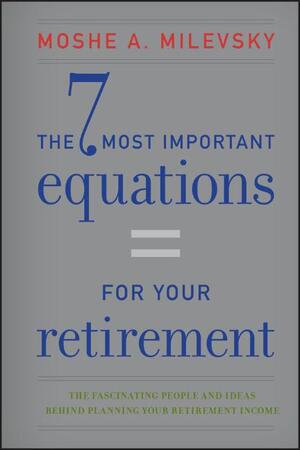7 Important retirement equations
Don't let the seemingly arcane mathematical formulae turn you off of Moshe Milevsky's latest book, The 7 Most Important Equations for Your Retirement.
Advertisement
Don't let the seemingly arcane mathematical formulae turn you off of Moshe Milevsky's latest book, The 7 Most Important Equations for Your Retirement.

 Fans of finance professor and prolific author Moshe Milevsky may have mixed feelings about his latest book, The 7 Most Important Equations for Your Retirement.
These days, not everyone is as numerate as they should be, so I could see how some readers might be scared off by the seemingly arcane mathematical formulae around which Milevsky builds this book.
All I can say is that those who would rather not revisit their high-school algebra or calculus can nevertheless benefit from the seven underlying lessons.
If you’re a history or biography buff, the bonus in this book is that Milevsky also provides some colorful profiles of the people who developed these formulae underpinning the theory of generating retirement income. But again, you can still benefit even if you’re not up to speed on such finance luminaries as Leonardi Fibonacci, Irving Fisher or Paul Samuelson (of special interest is Milevsky’s anecdote about his personal interaction with Samuelson).
Assuming you are primarily interested in financial independence, retirement or whatever you wish to call it (de-accumulation planning is one term Milevsky uses) you will care about the seven big questions that serve as Milevsky’s chapter titles.
They are:
1.) How long will my number last?
2.) How long will I spend in retirement?
3.) Is a pension annuity worth it?
4.) What is a proper spending rate?
5.) How much in risky stocks versus safe cash?
6.) What is your financial legacy today?
7.) Is my current plan sustainable?
Before he gets to these questions, Milevsky provides a reality check about modern consumers. First, most are not saving enough money to maintain their current standards of living; second, many of them are financially illiterate.
For those who are financially illiterate and innumerate, Milevsky does take pains to put his equations into everyday English. If I were a financial adviser, I’d want to have a copy in my office clearly visible, if only to impress clients. But for those of us who are clients of financial professionals, it would be almost as much fun to procure a copy and bounce some of the content off your adviser. This might have two positive results: one, you’d be serving notice that you’re a serious client when it comes to the mathematics of retirement. Second, you could assess the expertise of the particular professional with whom you’re currently doing business.
Those who persevere until chapter 7 will be rewarded with a (supposedly) “purely imaginary” case study of Moshe and Edna in the year 2035, one which probably reflects the financial circumstances of the author himself.
Fans of finance professor and prolific author Moshe Milevsky may have mixed feelings about his latest book, The 7 Most Important Equations for Your Retirement.
These days, not everyone is as numerate as they should be, so I could see how some readers might be scared off by the seemingly arcane mathematical formulae around which Milevsky builds this book.
All I can say is that those who would rather not revisit their high-school algebra or calculus can nevertheless benefit from the seven underlying lessons.
If you’re a history or biography buff, the bonus in this book is that Milevsky also provides some colorful profiles of the people who developed these formulae underpinning the theory of generating retirement income. But again, you can still benefit even if you’re not up to speed on such finance luminaries as Leonardi Fibonacci, Irving Fisher or Paul Samuelson (of special interest is Milevsky’s anecdote about his personal interaction with Samuelson).
Assuming you are primarily interested in financial independence, retirement or whatever you wish to call it (de-accumulation planning is one term Milevsky uses) you will care about the seven big questions that serve as Milevsky’s chapter titles.
They are:
1.) How long will my number last?
2.) How long will I spend in retirement?
3.) Is a pension annuity worth it?
4.) What is a proper spending rate?
5.) How much in risky stocks versus safe cash?
6.) What is your financial legacy today?
7.) Is my current plan sustainable?
Before he gets to these questions, Milevsky provides a reality check about modern consumers. First, most are not saving enough money to maintain their current standards of living; second, many of them are financially illiterate.
For those who are financially illiterate and innumerate, Milevsky does take pains to put his equations into everyday English. If I were a financial adviser, I’d want to have a copy in my office clearly visible, if only to impress clients. But for those of us who are clients of financial professionals, it would be almost as much fun to procure a copy and bounce some of the content off your adviser. This might have two positive results: one, you’d be serving notice that you’re a serious client when it comes to the mathematics of retirement. Second, you could assess the expertise of the particular professional with whom you’re currently doing business.
Those who persevere until chapter 7 will be rewarded with a (supposedly) “purely imaginary” case study of Moshe and Edna in the year 2035, one which probably reflects the financial circumstances of the author himself.
 Milevsky fans already know he’s in favor of heavy exposure to stocks and as of this book, he confesses that he personally remains “heavily invested in them” because he has a long time horizon and doesn’t plan to stop working until he’s 70 years old. His analysis of human and financial capital will also be familiar since he has already devoted an entire book to the topic (Are you a stock or a bond?).
In short, if you’re serious about financial independence, don’t let a few scary-looking equations put you off. This one belongs in your personal finance library.
Milevsky fans already know he’s in favor of heavy exposure to stocks and as of this book, he confesses that he personally remains “heavily invested in them” because he has a long time horizon and doesn’t plan to stop working until he’s 70 years old. His analysis of human and financial capital will also be familiar since he has already devoted an entire book to the topic (Are you a stock or a bond?).
In short, if you’re serious about financial independence, don’t let a few scary-looking equations put you off. This one belongs in your personal finance library.
Share this article Share on Facebook Share on Twitter Share on Linkedin Share on Reddit Share on Email